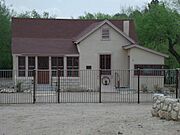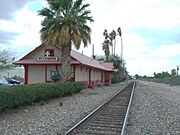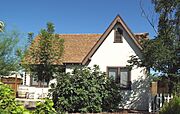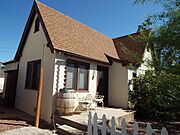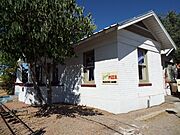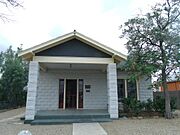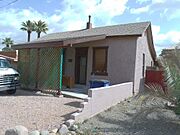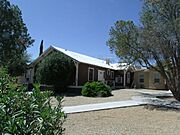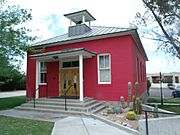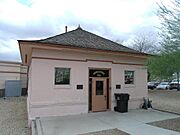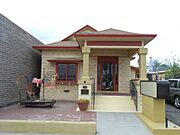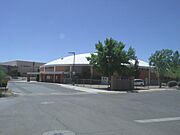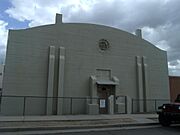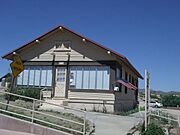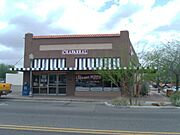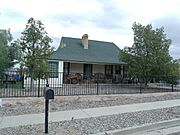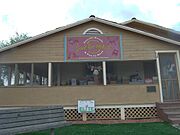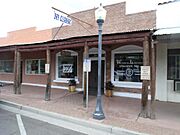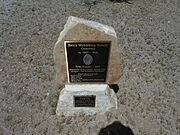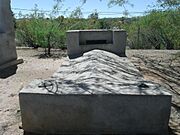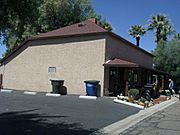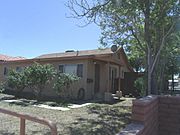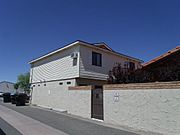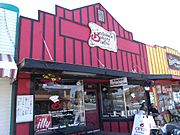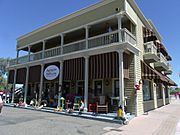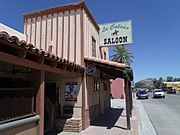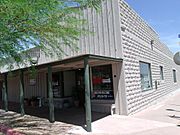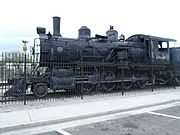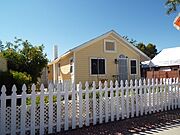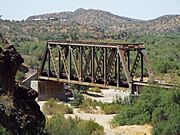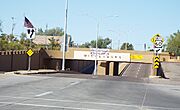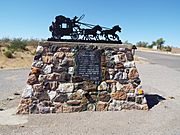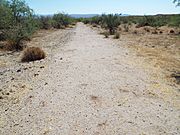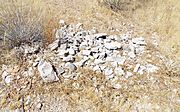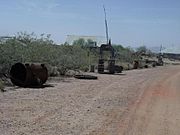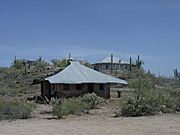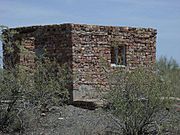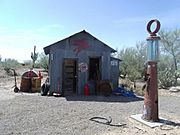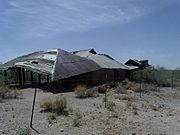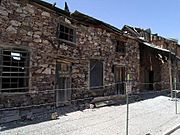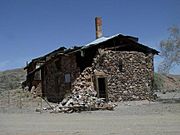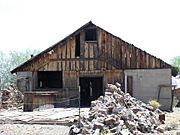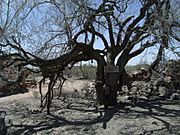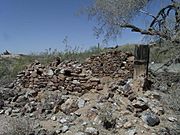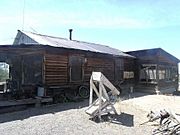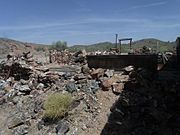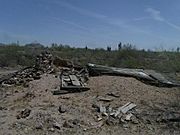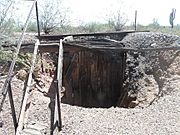Quick facts for kids
List of historic properties
in Wickenburg, Arizona
|
|
|

Frontier Street
|
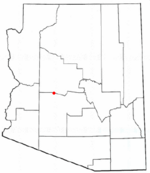
|
Wickenburg, Arizona, is a town with a rich history! Many of its old buildings and places are still standing today. This article shows you some of these cool historic spots. Some are even listed on the National Register of Historic Places, which means they are super important to American history. Others are recognized by the Wickenburg Chamber of Commerce. You'll also see pictures from the old Vulture Mine and Vulture City, a ghost town nearby.
Discovering Wickenburg's Past
The story of Wickenburg begins with gold! In 1863, a prospector named Henry Wickenburg found a huge gold deposit. This discovery led to the creation of the Vulture Mine. It became the most successful gold mine in Arizona's history. From 1863 to 1942, it produced a massive amount of gold and silver!
Vulture City: A Mining Ghost Town
Right next to the Vulture Mine, a small mining town called Vulture City grew. It was founded in 1863. Henry Wickenburg himself became the town's first Post Master in 1880. Vulture City had many buildings, including boarding houses, stores, and even a school. The large Vulture Mine–Assay Office, built in 1884, is still standing today.
At its busiest, Vulture City had about 5,000 people living there. Life in the mining town could be tough. There was even a famous "Hanging Tree" near Henry Wickenburg's old house, used for justice in the early days.
The Birth of Wickenburg Town
In the same year, 1863, miners, ranchers, and farmers started building homes along the Hassayampa River. This was the beginning of the town of Wickenburg. Many of the first businesses built structures that still make up Wickenburg's downtown area.
Sadly, some historic buildings are in danger of falling apart or being torn down. It's important for people to work together to save these pieces of history before they are lost forever.
Here are some historic buildings that no longer exist:
- The Santa Fe Bunk House
- The Sunset Telephone Co.
- The PJ Thompson House
- The Masonic Hall
- The Wickenburg Ice and Cold Storage
Historic Buildings in Wickenburg
These photos show some of the historic buildings in Wickenburg that are listed on the National Register of Historic Places.
- Historic Wickenburg, Arizona
-
Henry Wickenburg built the Wickenburg-Boetto House in 1900. It's at 225 S. Washington and was listed in 1986.
-
The Santa Fe Railroad Depot was built in 1895. It's now the local visitor's center. Listed in 1986.
-
This house at 160 Apache Street was built in 1923 and listed in 1986.
-
Another view of the House at 160 Apache Street.
-
This house at 170 Center Street was built in 1925 and listed in 1986.
-
Another view of the House at 170 Center Street.
-
The House at 186 Washington was built in 1900 and listed in 1986.
-
The Jacobs House was built in 1900 at 355 N. Jefferson. Listed in 1986.
-
The Wisdom House was built in 1900 at 48 Kerkes. Listed in 1987.
-
The Cactus Inn was built in 1900 at 158 Yavapai Street. Listed in 1986.
-
The Vernetta Hotel was built in 1905. It was first called the Smith Hotel. Now it's the Hassayampa Building. Listed in 1986.
-
The Garcia School was built in 1905 on Yavapai. Listed in 1982.
-
The City Hall & Jail was built in 1909 at 117 Yavapai. Listed in 1986.
-
The Old Barber Shop, also known as the "Helm Barber Shop", was built in 1910 at 68 Frontier. Listed in 1986.
-
The George B. Upton House was built in 1920 at 172 Washington. Listed in 1986.
-
Wickenburg High School and Annex is at 250 Tegner Street. Listed in 1986.
-
The Wickenburg High School Gym was built in 1920 at 252 Tegner. Listed in 1986.
-
The Santa Fe Section House was built in 1925 at 279 Railroad Street. It provided lodging for railroad workers. Listed in 1986.
-
Safeway Pay and Takit was built in 1925 at 42 N Tegner. Listed in 1986.
-
The MacLennan House was built in 1925 at 339 N. Jefferson. Listed in 1986.
-
The Shride House was built in 1925 at 58 Tegner. Listed in 1986.
-
The Old Brick Post Office was built in 1930 at 144 N Frontier. Listed in 1986.
-
This is a plaque at the entrance of the Henry Wickenburg Pioneer Cemetery. The cemetery was listed in 2011.
-
The Tomb of Henry Wickenburg is in the Henry Wickenburg Pioneer Cemetery on Adams Street. The cemetery was listed in 2011.
More Historic Spots in Wickenburg
These photos show other historic places in Wickenburg, recognized by the Wickenburg Chamber of Commerce.
- Additional historic structures and properties.
-
The Jail Tree is at the corner of Tegner and Wickenburg Way. From 1863 to 1890, if the jail was full, prisoners were chained to this tree!
-
The Trinidad House was built in 1863. It might be the oldest house in Arizona! It was a military post, a stage stop, and a store.
-
The Eller General Store was built in 1864.
-
The Orosco and Kerkes House was built in 1869. It was owned by Fernando Orosco, a Hispanic pioneer.
-
The Villa House was built in 1890. It was home to one of Wickenburg’s early Hispanic families.
-
Hyders Livery Stable was built in 1890. When cars became popular, it turned into a garage. Now it's a parish house.
-
The historic Pastime Pool Hall building was built in 1893. It was first a grocery store, then a pool hall.
-
The Texas Hotel was built in 1895. It was moved to this spot around 1904. It had a restaurant and eight rooms for rent.
-
The WW Bass House was built in 1908. It was the home of Mr. & Mrs. Bass. Mr. Bass was a famous early Arizona photographer.
-
This building, built in 1918, first housed the Wickenburg Drug Company, then Jones’ Pharmacy. It later became a bank.
-
The Garcia-Ocampo House was built in 1921 by Marcella Ocampo, a local businesswoman from an early Hispanic family.
-
Engine 761 is a steam locomotive built around 1890. It used to run on the main line between Chicago and the west. It's now next to the historic train depot.
-
This is the gravesite of Garth A. Brown in Wickenburg Municipal Cemetery. He was the Mayor of Wickenburg from 1970 to 1972.
-
The Saguaro Theatre was built in 1948 by Dwight "Red" Harkins.
-
This house was built in the 1920s and moved to Apache Street from the Vulture Mine area.
-
This is the Pratt through truss BNSF Railroad Bridge, built in 1930. It crosses the Hassayampa River in Wickenburg.
-
The Wickenburg Underpass was finished in 1937. It has one bridge for trains and another for cars.
-
This marker shows the area where the Wickenburg Massacre happened. Six stagecoach passengers were killed here on November 5, 1871.
-
This is the Old Stage Coach Road where the Wickenburg Massacre took place on November 5, 1871.
-
This is the grave of one of the victims from the November 5, 1871, Wickenburg Massacre.
Exploring Vulture City: A Ghost Town
These photos take you to historic Vulture City, a ghost town, and the Vulture Mine itself!
- Historic Vulture City (Ghost town) and the Vulture Mine
-
Vulture Mine Historic Marker.
-
Some of the old mining equipment once used.
-
The Vulture City Gate House.
-
Some of the Ghost town houses in Vulture City.
-
The Vulture City Dynamite House where dynamite and ammo were stored.
-
The Vulture City Gas Station.
-
The Vulture City Workshop.
-
The Vulture Mine-Assay office, built in 1884.
-
A side view of the Vulture Mine-Assay office.
-
A full view of the Vulture_Mine-Assay office.
-
The Vulture City Chow House where the miners ate.
-
The kitchen inside the Vulture City Chow House.
-
The Vulture City Hanging Tree.
-
The ruins of Henry Wickenburg's Settlers Home in Vulture City.
-
One of the Miners Living Quarters in Vulture City.
-
The ruins of the Vulture City Saloon.
-
The ruins of the Vulture City Post Office, which opened in 1880. Henry Wickenburg was its postmaster.
-
The Vulture Mine, Vulture Mountain and caves.
-
-
The entrance to the Vulture Mine gold mine shaft.
-
Inside the entrance of the gold mine shaft.
See also





